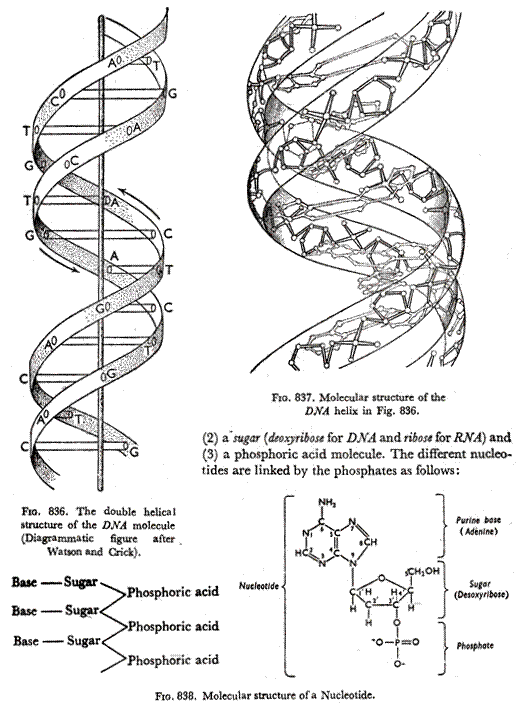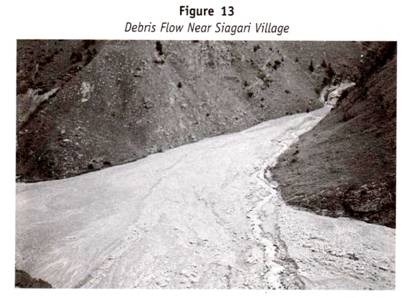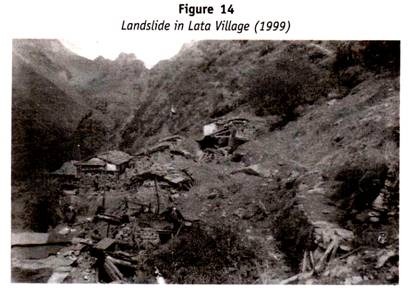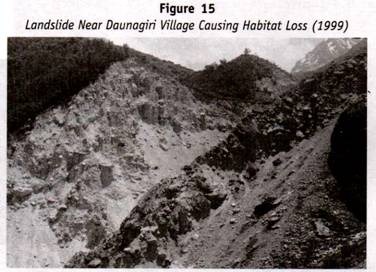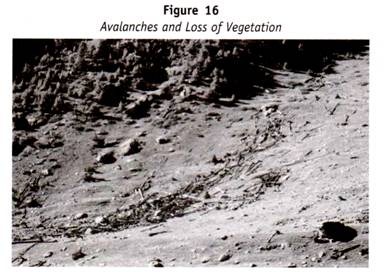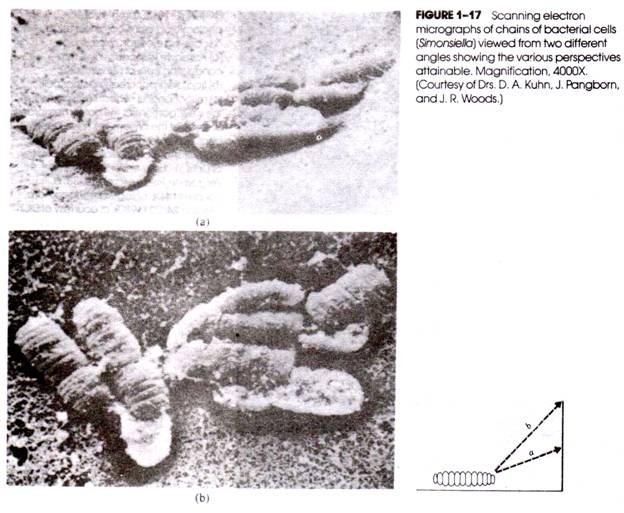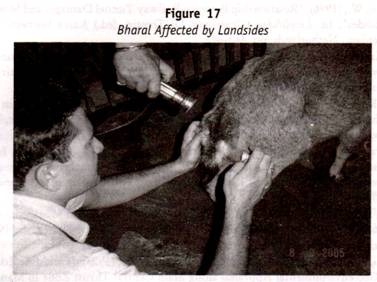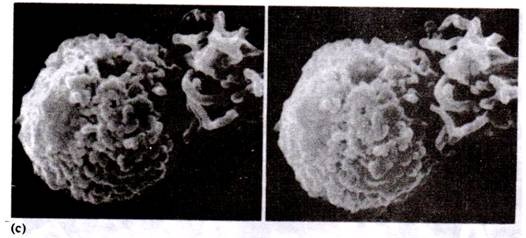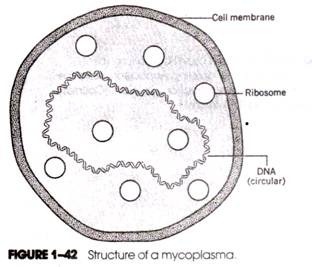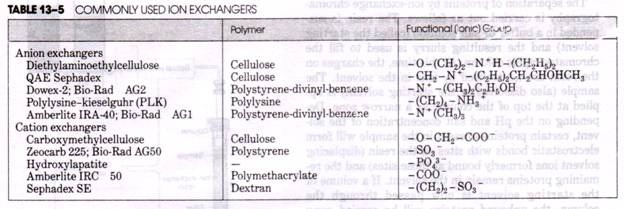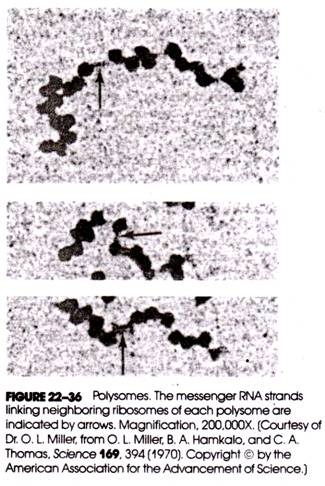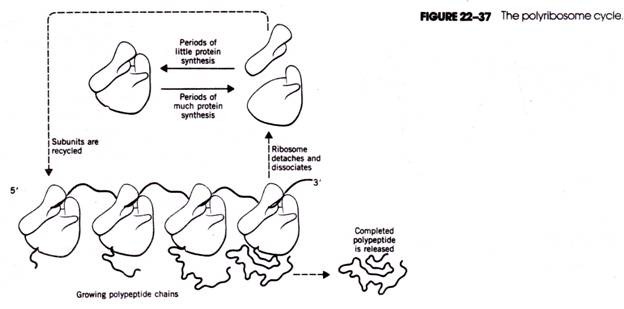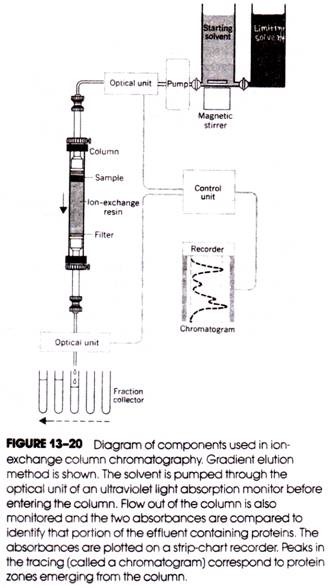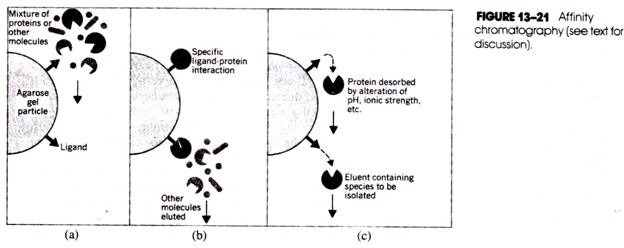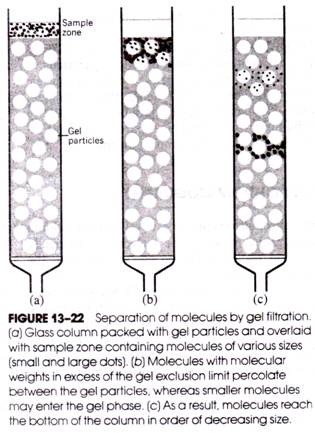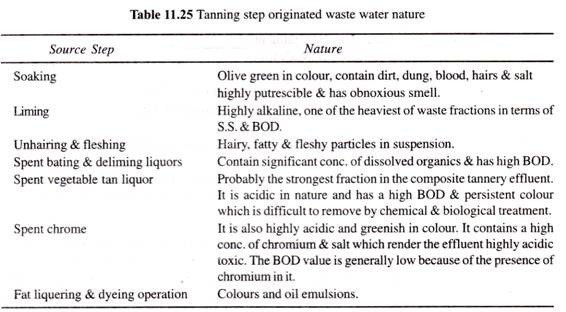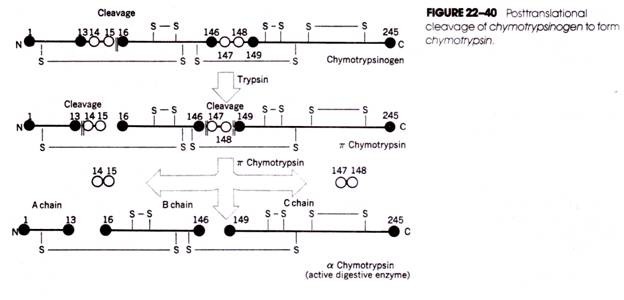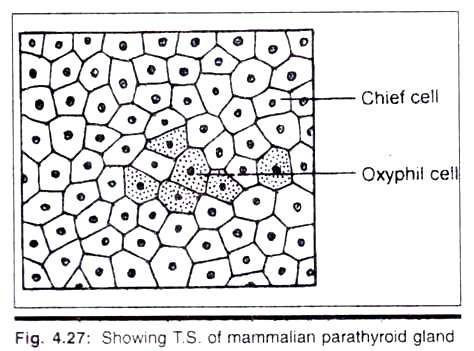The following points highlight the thirty-one major representative types of protozoa present in animal body. Some of the types are: 1. Chrysamoeba 2. Cryptomonas 3. Volvox 4. Ceratium 5. Noctiluca 6. Proterospongia 7. Mastigamoeba 8. Trichonympha 9. Giardia 10. Leishmania 11. Trichomonas 12. Opalina 13. Pelomyxa 14. Arcella 15. Difflugia and Others.
Protozoa: Type # 1. Chrysamoeba:
Chrysamoeba (Fig. 22.1) is found in freshwater. Body egg-shaped while swimming but becomes amoeboid when on the substratum. Locomotory organ single flagellum. Protoplasm contains single nucleus, two or more contractile vacuoles and two yellow chromatophores. Gullet or cytopharynx and skeleton absent. Nutrition is holophytic or holozoic. Food ingestion takes place by means of pseudopodia.
Protozoa: Type # 2. Cryptomonas:
Cryptomonas (Fig. 22.2) is found among algae containing chloroplasts in fresh and marine waters. The body is covered by a thin pellicle and provided with two flagella and a gullet. Protoplasm contains single nucleus and two usually green chromatophores. Locomotion by flagella. Nutrition is holophytic or saprophytic. Reserve food material is in the form of starch and oil.
Protozoa: Type # 3. Volvox:
Volvox (Fig. 22.3) is a colonial flagellate. V. globator and V. aureus are cosmopolitan in freshwaters.
The colony has a gelatinous matrix forming a round hollow ball filled with a fluid, it is known as a coenobium. In the matrix is a single layer of many biflagellate zooids (Fig. 22.4) connected to each other by protoplasmic bridges. There are two kinds of zooids in the colony, somatic or vegetative zooids are numerous and small and reproductive zooids are few and larger in size.
The zooids are independent but all contribute to coordinated locomotion by their flagella. A zooid has a cellulose wall outside the cell membrane, it has a curved chloroplast with chlorophyll and pyrenoids, the product of photosynthesis is starch; there are two or more contractile vacuoles, a red stigma, and two projecting flagella.
Volvox is of special significance because it shows a transition from a unicellular to a multicellular organism; it shows a differentiation into somatic cells which are trophic but unable to reproduce and into reproductive germ cells; the somatic cells die but germ cells live on as in Metazoa; it also illustrates a stage through which the ancestors of Metazoa must have passed in the course of evolution.
Asexual Reproduction:
The reproductive zooids from the posterior side of the colony enlarge to form parthenogonidia which divide repeatedly by longitudinal binary fission to form a daughter colony. The cells of the daughter colony become arranged into a hollow ball called a plakea in which the flagellated ends of the cells point inwards, the plakea then turns inside out so that the flagellated ends of cells come to the exterior.
These daughter colonies become motile but remain inside the parent coenobium, finally they escape by rupturing the wall of the parent or when the parent dissociates.
Sexual Reproduction:
V. globator is monoecius but V. aureus is dioecious. Monoecious forms are protandrous hermaphrodites. True eggs or sperms are formed from reproductive zooids. The reproductive zooids drop into the hollow of the coenobium, they divide to form bundles of microgametes (sperms) in multiples of sixteen; a microgamete has two flagella. Later some other reproductive zooids enlarge to form macrogametes (ova) which remain in the colony.
Microgametes escape from the colony and bring about cross fertilisation to form zygotes; the zygote acquires a thick, brown, spiny shell. Next spring the zygote divides repeatedly to form a new colony. The old colony dies and new colonies escape. (This is an example of natural death in Protozoa). The gametes are haploid and the zygote diploid, meiosis occurs in the zygote.
Thus, meiosis occurs after the formation of the zygote and is post-zygotic (in Metazoa it is pre-zygotic). In both sexual and asexual reproduction the zooids of the young colony have their flagella pointing inwards but inversion takes place before the new colony is completed. Some macrogametes develop parthenogenetically into colonies.
Protozoa: Type # 4. Ceratium:
The body of Ceratium (Fig. 22.5) is enclosed in a thick pellicle of cellulose called lorica which is made of closely fitting platelets. There are two to five but usually three armored spines, one anterior and two posterior. From the body arise two flagella, one in a transverse groove or annulus which encircles the body and the other in a longitudinal groove or sulcus which goes backwards.
The annulus is interrupted ventrally by a large membranous plate. There are rod-shaped chromatophores distributed in five distinct groups, they contain chlorophyll, nutrition is holophytic. Chromatophores are green in freshwater forms but they are yellowish-brown in marine forms. There are reserves of starch, glycogen and fat droplets.
The cytoplasm contains foreign bodies such as bacteria, flagellates and diatoms. Feeding in colourless forms is done by extruding a single large or many small parts of the cytoplasm through pores, the latter form an anastomosing net on the body which entangles the prey for holozoic nutrition, partly digested food is withdrawn along with the cytoplasm into the body.
Even coloured forms use this method and do not rely entirely on photosynthesis as a means of nutrition. Ceratium hirudinella is found in freshwater and the sea, other species occur all over the world in lakes and seas. Reproduction is by binary fission.
Protozoa: Type # 5. Noctiluca:
The body of Noctiluca (Fig. 22.6) is spherical, about 1.5 mm in diameter, it is gelatinous and transparent, it is covered by thick pellicle, protoplasm is highly vacuolated and has delicate strands. There is a groove in the pellicle which is held uppermost in floating, but it marks the morphological ventral side.
In the groove lies an elongate mouth and a soft flap inappropriately called a tooth which represents a transverse flagellum.
Grouped close to the groove are a nucleus, flagella and mouth, all of them together are called a polar mass. From the polar mass branching and anastomosing threads of protoplasm pass into the interior. The central cortex is phosphorescent producing bluish-green light at night, hence, the name.
Myriads or Noctiluca light up the sea. Two flagella arise from the groove, a small flagellum and a large one modified into a stout, striated tentacle. It is marine, pelagic and holozoic, it reproduces by binary fission and by formation of spores after multiple fission. These spores are more like dinoflagellates than the adult.
Protozoa: Type # 6. Proterospongia:
Proterospongia (Fig. 22.7) is a free-living flagellate. It has a gelatinous matrix of irregular shape in which many zooids are embedded forming a colony. A zooid is an oval cell with a transparent collar at one end through which a flagellum comes out, these collared zooids are embedded on the outside. Inside the matrix are also some amoeboid zooids. Proterospongia colony resembles sponges closely.
Protozoa: Type # 7. Mastigamoeba:
Mastigamoeba (Fig. 22.8) is a free-living flagellate found in freshwater ponds and lakes. It has a permanently amoeboid form. It possesses a single flagellum and- numerous pseudopodia. Protoplasm contains single nucleus and contractile vacuole. Locomotion by pseudopodia. Nutrition is holozoic. It is considered to be a connecting link between Mastigophora and Rhizopoda.
Protozoa: Type # 8. Trichonympha:
Trichonympha (Fig. 22.9) is one of the many genera of flagellates found in the gut of termites. Body has a complicated structure, and a large number of flagella are found in groups over the surface of the entire cell. In the ectoplasm are oblique fibres, an alveolar layer and transverse myonemes, in the endoplasm are longitudinal myonemes.
There is a symbiotic relationship between Trichonympha and its host, it renders the cellulose of wood eaten by the termite digestible by the termite. Without the flagellates wood is not digested by termites. The flagellate lives in and obtains its food from the termite.
Protozoa: Type # 9. Giardia:
Giardia intestinalis (Fig. 22.10) also called G. lamblia (old name Lamblia) is a parasite in the small intestine and colon of man, being attached in masses to the mucous membrane from where it absorbs food consisting mainly of mucus.
Occasionally the parasites invade the bile ducts and gall bladder. Other species of Giardia are parasitic in the intestine of vertebrates. Giardia has an elliptical body which is bilaterally symmetrical.
The dorsal side is convex, but the ventral surface may be flat or convex. The anterior end is rounded and the posterior end is tapering. In the anterior half of the ventral surface is rhizoplasts a concave sucking disc for attachment to the host. There are two vesicular nuclei and four pairs of long flagella.
Passing through the cytoplasm from the anterior to the posterior end are two parallel, flexible, needle-like axostyles which support the body, the nuclei are attached by fibrils to the axostyles. Just behind the sucking disc is a deep staining parabasal body.
Giardia prevents absorption of fats by the host, the unabsorbed fats cause diarrhoea. It forms oval, thick-walled cysts, division occurs in the cyst so that the cyst has four nuclei, the cysts pass out with the faeces and are infective for 10 days or more. Antimalarial drugs such as atebrin and chloroquin are effective in removing the parasites.
Protozoa: Type # 10. Leishmania:
The genus Leishmania (Fig. 22.11) includes three species which are common parasites of man, viz:
(i) Leishmania donovoni,
(ii) Leishmania tropica, and
(iii) Leishmania brassiliensis.
Leishmania donovoni has two phases in the life cycle, one flagellar Leishmania form in the reticulo-endothelial cells of man and other Leptomonas form in the gut of blood-sucking fly Phlebotomus. Leishmania form is intracellular and is found in the cells of liver, spleen, bone marrow, intestine and lymph glands in the reticulo-endothelial system.
This form is oval or spherical 1-3 µ in diameter with a limiting membrane, the periplast or pellicle. The cytoplasm contains an oval nucleus, rod- shaped or dot-like kinetoplast and parabasal body. Reproduction by binary fission.
(i) Leishmania donovoni causes kala azar which is a chronic disease characterised by the enlargement of liver, spleen and by an irregular fever, anemaia and leucopenia.
(ii) L. tropica causes oriental sore or Delhi boils.
(iii) L. brassiliensis causes mucocutaneous American leishmaniasis.
Protozoa: Type # 11. Trichomonas:
The body of Trichomonas (Fig. 22.12) is pear-shaped tapering posteriorly, provided with four flagella of which one is directed backwards united to the body by an undulating membrane. Cytostome is present antero-ventrally and is used for the ingestion of food.
An axostyle which is stout, rod-like extends from the posterior end medially through the body. Basal granule (blepharoplast) is minute structure situated at the anterior end, while parabasal body is club- shaped extends posteriorly from the basal granule. Single large nucleus situated anteriorly. Reproduction asexual by longitudinal binary fission. Trichomonas are parasites in many vertebrates and in few invertebrates.
Three species are found in man which are as follows:
(i) T. hominis in the colon;
(ii) T. buccalis in the mouth;
(iii) T. vaginalis in the human vagina.
Protozoa: Type # 12. Opalina:
Opalina (Fig. 22.13) is a parasite in the rectum of frogs and toads. Body is oval and flat with longitudinal rows of many equal-sized cilia-like organelles of locomotion. It is multinucleate, each nucleus has both trophochromatin and idiochromatin. There is no cytostome or contractile vacuole.
The parasite absorbs digested food of the host. Reproduction is by longitudinal binary fission most of the year, in fission kinetia are not cut but shared equally between two daughter cells, this is an interkinetal division of kinetia.
In spring reproduction is by binary plasmotomy in which cell division is repeated again and again without division of the nuclei, so that many daughter cells are produced, each having only a few nuclei, generally three to six. The daughter cells become encysted and pass out of the host into water from where they are swallowed by tadpoles.
The cysts dissolve in the intestine of tadpoles and the cells divide to form uninucleate microgametes or macrogametes, these gametes are anisogametes. The male and female anisogametes fuse to form a zygote. The zygote encysts, then by growth and nuclear division it becomes an adult which emerges from the cyst into the alimentary canal.
Previously Opalina was placed in Ciliophora, then it was placed in Flagellata, but, now it is placed in a separate superclass Opalinata since it is neither a ciliate nor a flagellate because of the following reasons:
1. Its many nuclei are similar or monomorphic, while in ciliates the nuclei are dimorphic, they are micronucleus and macronucleus.
2. In binary fission the Cleavage is longitudinal and parallel to kinetia which are shared by the daughter cells and new kinetia are supplied by the primary ones to complete the number; in ciliates binary fission is generally transverse, the cleavage cuts the kinetia across so that the daughter cells receive half of each kinety which, thus, have genetic continuity.
3. In Opalina there is no conjugation which is common in ciliates.
4. In Opalina anisogametes are formed and sexual reproduction is by syngamy, while in ciliates sexual reproduction is by conjugation or autogamy, and no gametes are formed.
5. It has no chromatophores, contractile vacuole, and gullet as seen in flagellates.
Protozoa: Type # 13. Pelomyxa:
Pelomyxa (Fig. 22.14) also called Chaos is an amoeba of large size being about 2.5 mm long. The body is asymmetrical and the body shape changes constantly. It has a single large, hyaline and blunt pseudopodium, cytoplasm has many small nuclei, food vacuoles, rod-like bacteria, particles of sand and reserve food material in the form of glycogen granules.
There are many fluid-filled vacuoles but none is contractile. It is found in mud of ponds rich in vegetable matter, it feeds by ingesting mud.
Reproduction:
(a) Plasmotomy occurs in which the multinucleate cell divides by binary fission into two or more daughter cells, but the nuclei do not divide, they are shared by the daughter cells. Later each daughter cell regains the normal number of nuclei by nuclear division, (b) Reproduction also occurs by formation of gametes.
Protozoa: Type # 14. Arcella:
Arcella (Fig. 22.15) is a common freshwater amoeba found in freshwater ponds having weeds. The amoeboid body is symmetrical, it secretes a pseudochitinous shell of brown or yellow colour, the shell is single-chambered or unilocular, it is like a half globe and may be sculptured. The shell is made of siliceous prisms embedded in a chitinoid substance known as tectin.
The cytoplasm is joined to the shell by ectoplasmic strands.
Ventrally the shell has an aperture called pylome from which 3 or 4 pseudopodia project. In the cytoplasm are two or more vesicular nuclei, and a ring of granules called chromidia, it has now been shown that chromidia are not made of chromatin as believed earlier, but are secretory granules. There are several contractile vacuoles, food vacuoles and some gas vacuoles filled with oxygen.
Reproduction:
Two nuclei divide into four nuclei, two of which along with some cytoplasm are extruded from the pylome, this extruded mass secretes a new shell, the double-shelled animal divides into two daughter cells, each of which receives a shell, then the daughter cells separate.
Protozoa: Type # 15. Difflugia:
Difflugia (Fig. 22.16) is a shelled amoeba found in freshwater. It has an oval body to which particles adhere to form a spherical or oval shell. In locomotion pseudopodia are extended one after another through an opening in the shell, their tips are attached to the substratum, then the pseudopodia contract and the shell containing the body is pulled forward. Contraction of pseudopodia is much more than in Amoeba.
Protozoa: Type # 16. Allogromia:
Allogromia (Fig. 22.17) is found both in fresh and marine waters. The body of the animal is covered by a shell which is one chambered (unilocular or monothalamous).
The protoplasm flows out from the terminal opening of the shell and flows around the shell, in this way shell becomes internal. Protoplasm contains a single nucleus, a contractile vacuole and a food vacuole. Pseudopodia or reticulopodia are very long and delicate, unite to form a complicated network. They serve the animal in catching the prey. Reproduction by multiple fission.
Protozoa: Type # 17. Globigerina:
Globigerina (Fig. 22.18) is marine floating on the surface. The animal secretes a calcareous shell of a few round chambers lying in a rising spiral or helicoid arrangement, some species have long spines on the shell. When the living shell chamber becomes small for the animal, it secretes a new larger chamber, this many-chambered shell is known as a multilocular shell in which all the chambers communicate.
The shell is made of calcium carbonate having some magnesium sulphate and silica. The shell has apertures through which fine, branching and anastomosing pseudopodia called rhizopodia or reticulopodia emerge.
When the animals die their shells sink to the bottom of the Atlantic Ocean where they form a gray “Globigerina ooze” which is rich in lime and silica, it covers an area of 20 million square miles. Chalk is made from the ooze.
Protozoa: Type # 18. Thalassicola and Acanthometra:
Thalassicola (Fig. 22.19) is marine and pelagic; it has a perforated and membranous central capsule which divides the protoplasm into an intra-capsular endoplasm containing pigment granules, crystals, oil globules and a polyenergid nucleus in which there are several sets of chromosomes, and just outside the capsule into an extra capsular fluid ectoplasm which contains food vacuoles.
A similar fluid layer of ectoplasm is spread over the outer surface and from this are given out delicate thread-like pseudopodia known as filopodia. Between the outer and inner zones of ectoplasm is the calymma, a thick, highly vacuolated and gelatinous material.
The calymma is a floating device, when it collapses the animal sinks, and when bubbles reform in it the animal rises. In the calymma are many food vacuoles and numerous symbiotic Zooxanthellae called yellow cells. Zooxanthellae are symbiotic algae or flagellates in the palmella stage. There is no contractile vacuole.
The majority of other Radiolaria have a central capsule and a siliceous skeleton which is absent in Thalassicola. The radiolarian skeleton may be made of long spines or needles which radiate from the central capsule and extend outside the body as in Acanthometra, (Fig. 22.20) or the skeleton may be made of lattice-like spheres arranged concentrically.
The siliceous skeletons of Radiolaria form a “Radiolarian ooze” covering three million square miles of the floor of the Indian and Pacific Oceans; Reproduction is by binary and multiple fission.
In Thalassicola the central capsule separates from the animal and descends into the sea, its nucleus and cytoplasm divide to form many small cells called isopores which develop two unequal flagella in each, the isopores escape from the capsule and develop into adults.
Protozoa: Type # 19. Collozoum:
Collozoum (Fig. 22.21) is a colonial form having a sub spherical body measuring about 3-4 cm in length. Protoplasm is divided into an intra-capsular and an extra capsular protoplasm by a perforated membrane. The vacuolated extra capsular protoplasm is common to the entire colony having numerous central capsules embedded in it.
Each central capsule indicates a zooid of the colony, which has a single nucleus. The central capsule undergoes repeated divisions, while the extra capsular protoplasm does not divide. Skeleton and contractile vacuoles are completely absent. Reproduction by merogony. Marine form found in the deep sea.
Protozoa: Type # 20. Lithocircus:
Lithocircus (Fig 22.22) is a marine form generally found in the deep sea. Body is covered by a shell of siliceous skeleton. The animalcule is provided with a central capsule embedded in the protoplasm. The central capsule divides the protoplasm into extra capsular and intra-capsular protoplasm.
Extra capsular protoplasm gives rise to radiating threadlike pseudopodia, while intra-capsular protoplasm contains large single nucleus.
Contractile vacuole absent. Reproduction asexual by binary fission. Lithocircus exhibits the phenomenon of symbiosis. The yellow cells of Zooxanthellae (green algae) occur in the extra capsular protoplasm. Lithocircus supply the CO2 and nitrogenous waste material, while the Zooxanthellae supply O2 and starch. In this way both the organisms are mutually benefited.
Protozoa: Type # 21. Actinophrys:
Actinophrys sol (sun animalcule) (Fig. 22.23) is found both in fresh and marine waters feeding on flagellates and algae. The body is round from which radiate thin, long pseudopodia, each with a central axial filament covered with an adhesive, granular ectoplasm, such pseudopodia are called axopodia.
The axial filaments of axopodia are attached to the nuclear membrane, but in the multinucleate Actinosphaerium they are not connected to the nuclei but arise from the periphery of the medulla. The ectoplasm is frothy due to many vacuoles, there are one or two contractile vacuoles constant in position, they contract with violence.
Marine forms have no contractile vacuole. Endoplasm is granular having small vacuoles. It has a large nucleus and several food vacuoles.
The animal has the power of rising and sinking in water. Reproduction occurs by binary fission and also by paedogamy in which the animal withdraws its axopodia gorges itself on flagellates and encysts, the cyst is a double envelope, gelatinous outside and membranous within, then it divides into many uninucleate secondary cysts.
Each secondary cyst divides into two cells enclosed in the cyst, the nucleus of each cell divides twice to form four nuclei with reduction in the number of chromosomes, three of the four nuclei degenerate. The two cells of a cyst and their nuclei fuse to form a diploid zygote. The zygote produces by binary fission and the daughter cells escape from the cyst, they grow into adults.
Protozoa: Type # 22. Actinospherium:
Actinospherium (Fig. 22.24) is found in freshwater floating among plants. The body is spherical measuring about 1 mm in diameter. The protoplasm is distinguishable into an outer layer, the ectoplasm or cortex and an inner central mass, the endoplasm or medulla. Ectoplasm contains large contractile vacuoles, while there are small vacuoles in the endoplasm.
Numerous nuclei (1-300) lie in the endoplasm. Pseudopodia or axopodia are numerous in the form of axial filaments and are more or less equal in length to the diameter of the body and serve as locomotory or food catching organelle. Nutrition is holozoic, voracious in feeding. Reproduction by binary fission, budding and multiple fission.
Protozoa: Type # 23. Clathrulina:
Clathrulina (Fig. 22.25) is found in freshwater. Body is enclosed in a perforated sphere of silica and provided with a stalk. Single nucleus. Reproduction involves the process of merogony in which merozoites are ovoid bodies provided with two flagella.
Protozoa: Type # 24. Gregarina:
Gregarina (Fig. 22.26) is a sporozoan parasite into the intestine or body cavity of insects or Annelida. The adult or trophozoite is extracellular, it has a thick cuticle, the ectoplasm has myonemes which grow in and divide the body into two parts, an anterior protomerite and a posterior deutomerite which contains a nucleus.
When the trophozoite is attached to the gut it acquires an anterior epimerite having radiating spines, it gets attached by the epimerite, but the epimerite is lost when the trophozoite comes to the lumen of the gut.
Life cycle:
Two trophozoites come together one behind the other, this is called syzygy, the anterior member in the chain is the primite or female, and the posterior member is the satellite or male. The trophozoites become rounded and are then called gametocytes which secrete a cyst.
The gametocytes divide by multiple fission to form gametes which are isogamous in some species and anisogamous in others. Gametes of different gametocytes fuse to form zygotes. The zygote secretes a sporocyst to become a spore. The spore divides asexually to form eight sporozoites. The spore becomes complicated by forming several tubes called sporoducts.
The sporozoites escape through the sporoducts and pass out with the faeces of the host to infect other insects in which they enter the cells of the intestinal epithelium and become intracellular. The sporozoites grow into trophozoites which remain attached, but project from the intestinal cells, later the trophozoites come into the lumen of the intestine.
Protozoa: Type # 25. Sarcocystis:
Sarcocystis (Fig. 22.27) is a parasite of vertebrates especially in sheep, rabbit, pig, rat, cattle, horses and also in reptiles and birds. It is occasionally found in man. The parasite forms a long spindle- shaped multinucleate cyst which is found embedded in the striped muscle fibres of the host.
The masses of spindlle-shaped parasites form long, slender, cylindrical bodies with pointed ends known as Miescher’s or Rainey’s tubes. Within each tube a large number of sickle-shaped spores are formed. These spores are known as Rainey’s corpuscles. Very little is known regarding the mode of transmission of this parasite. Sarcocystis causes a disease known as sarcosporidiosis.
Protozoa: Type # 26. Didinium:
Didinium (Fig. 22.28) is found in freshwater ponds and ditches in which Paramecium and other ciliates are in abundance. The body is barrel- shaped about 80-200 microns in length. Body is encircled by two hoops of cilia, one ring of cilia is close to the base of proboscis and the other on the posterior end.
The anterior end of the body is prolonged into a tubular proboscis made up of parallel trichocysts. The mouth opening or cytostome is situated at the tip of the proboscis. Protoplasm contains a horse-shoe-shaped nucleus in the centre, a contractile vacuole and cytopyge at the extreme posterior end of the body. Nutrition is holozoic. Reproduction by transverse binary fission and conjugation.
Protozoa: Type # 27. Balantidium:
Balantidium (Fig. 22.29) is a ciliate parasitic in the large intestine of pigs, monkeys, and man, some species are parasitic in frog, fish, cockroach and horse. It is an egg- shaped animal pointed at the anterior end and rounded posteriorly.
The body has longitudinal rows of small cilia. At the anterior end is a peristome with longer cilia, below the peristome is a mouth leading into short cytopharynx with no cilia (in B. entozoon parasitic in frog the peristome is a conical depression).
There is a large sausage-shaped macronucleus obliquely in the middle of the body, and in its concavity near it is a small micronucleus. Unlike most parasitic Protozoa there are two contractile vestibule vacuoles, one near the middle and a ectoplasm- larger one at the posterior end.
There are several food vacuoles containing food human erythrocytes and cell fragments, it also ingests starch and yeast from the colon of the host. At micronucleus the posterior end is a permanent cytoproct. Reproduction is by transverse binary fission and occasionally by conjugation in which there is an exchange of nuclear material and re-organisation of the macronucleus, this is followed by binary fission.
The parasite also forms thick-walled cysts, but no multiplication takes, place in the cyst. In human beings Balantidium coli causes ulcers and hemorrhage in the colon and caecum, which cause chronic dysentery. These parasites can be removed by administering small doses of aureomycin and terramycin for 10 to 15 days.
Balantidium is now placed in subclass Holotrichia, order Trichostomatida and not with Spirotrichia because:
1. Its peristomial ciliature develops from body kinetia which during binary fission form an incomplete band of stronger and longer cilia below the middle of the body, while in Spirotrichia the peristomial ciliature develops either from previous oral kinetosomes or from stomatogenetic kinetia.
2. It has no oral membranelle or buccal ciliature which are conspicuous in Spirotrichia.
Protozoa: Type # 28. Podophrya:
Podophrya (Fig. 22.30) is found in ponds having rich vegetation under decomposition. The body of Podophrya collini is globular, measures about 40-50 microns in diameter, provided with a stalk having a basal disc for the attachment with the substratum.
The body gives rise to 30-60 knobbed tentacles, giving a pin cushion-like appearance to the animal. Tentacles and the surface of the body are covered by gelatinous sheath. Endoplasm contains a large macronucleus in centre with 3-12 small micronuclei and a contractile vacuole. Cytostome is absent. Nutrition is holozoic. The food consists chiefly of Paramecia and other ciliates. Reproduction by internal budding.
Protozoa: Type # 29. Ephelota:
Ephelota (Fig 22.31) is a marine form, found in the sea water. The body is spherical and bearing a stalk. There are two types of tentacles on the body, viz., long pointed tentacles used for piercing and short cylindrical for sucking. Protoplasm contains an oval nucleus and few contractile vacuoles.
Reproduction by budding. The distal half of the animal may sprout a number of small elevations or buds. In budding process the nuclei behave as in the ordinary, binary fission. The macronucleus extends into each bud and divides directly.
Protozoa: Type # 30. Stentor:
Stentor (Fig. (22.32) is commonly found in freshwater ponds and ditches among aquatic plants and rich vegetation. Body of the organism is elongated, funnel-shaped and highly contractile, measuring from 1-2 mm in length. The body is sometimes attached by the base but often free itself to swim. The body is covered with cilia.
The anterior broad end bearing peristome is provided with large cilia which are arranged in clockwise manner. The posterior end is free of cilia but produces ramose pseudopodia for attachment. Protoplasm contains a beaded mega-nucleus or macronucleus, numerous micronuclei and anterior contractile vacuole. Reproduction by binary fission and conjugation.
Protozoa: Type # 31. Nyctotherus:
Nyctotherus (Fig. 22.33) is a parasitic ciliate in the rectum of frogs and intestine of cockroaches. Its body is kidney-shaped with the longitudinal rows of equal-sized cilia, and a row of large adoral cilia on the peristome. The large peristome leads into a long, curved cytopharynx in which cilia are large and wind clockwise.
In the anterior half of the body is a large kidney- shaped macronucleus and a small micronucleus, near the posterior end is a single contractile vacuole and at the posterior end is a permanent cytoproct.
Reproduction:
The animals conjugate with an exchange of nuclear material. The conjugants separate and undergo binary fission. These daughter cells encyst and pass out with the faces, these cysts are eaten by tadpoles in which they hatch and grow into adults and reach the rectum.


















